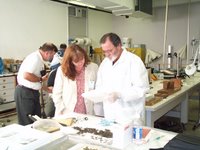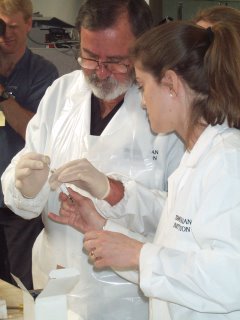
Editor’s note: An important member of the team of scientists and historians who studied the 142-year-old remains of Isaac Newton Mason was Dr. Larry Cartmell, a general pathologist from Ada, Okla., who is also an amateur archeologist. Tissue and hair samples taken by Cartmell while Mason’s body was in the conservation laboratory of Smithsonian forensic anthropologist Dr. Doug Owsley were analyzed for clues to how Mason died. Cartmell’s report has been sent to the Smithsonian, but he agreed to provide Pulaski Citizen/Giles Free Press readers a preview of his findings. The following interview was conducted with Cartmell via a series of emails with staff writer Claudia Johnson (pictured here with Cartmell)
By CLAUDIA JOHNSON
Staff Writer
C-P: How did you become involved with the Isaac Newton Mason project?
Cartmell: In a word (or sentence) Doug Owsley i
 nvited me. I first met Doug at a forensic anthropology course in the early 1990s, and he learned of my work in testing of ancient hair. I subsequently tested some hair for him from an iron coffin burial. In 2001 Doug invited me and Dr. Arthur C. Aufderheide, my mentor off and on for 15 years and, in my opinion the leading scientist in paleopathology, to participate in the autopsy of a historical figure in Chicago. This was also an iron coffin burial, which tend to preserve more soft tissue, and that is why Doug needed us to participate. C-P: What is the difference in the research you perform and that conducted by a scientist like Dr. Owsley?
nvited me. I first met Doug at a forensic anthropology course in the early 1990s, and he learned of my work in testing of ancient hair. I subsequently tested some hair for him from an iron coffin burial. In 2001 Doug invited me and Dr. Arthur C. Aufderheide, my mentor off and on for 15 years and, in my opinion the leading scientist in paleopathology, to participate in the autopsy of a historical figure in Chicago. This was also an iron coffin burial, which tend to preserve more soft tissue, and that is why Doug needed us to participate. C-P: What is the difference in the research you perform and that conducted by a scientist like Dr. Owsley?Cartmell: Forensic anthropologists basically do the bones, and as paleopathologist we do the soft tissue, hair analysis, toxicology, etc. He invited us both to help with the Mason project, but unfortunately Dr. Aufderheide was hospitalized three days before the project was to start and could not participate. Art and I work as a team, and he is reviewing my findings before they are released. C-P: With your responsibilities and busy schedule, why did you choose to go to DC for the week for this project? Cartmell: This is what I love to do. This is what gets me excited. The unknown, the chance to work with great scientists that I used to read about or see on TV such as Doug, Kari and Art. C-P: When I ran your name through a in internet search engine and read your resume, I found that most of your work has centered around mummies. How did the Mason project differ/how was it similar? Cartmell: You are correct that most of my research centers around mummies. My day-to-day work focuses on modern humans. The Mason project was sort of in-between. The Mason project was different than the mummies because we knew the probable identify and something of his life. The mummies generally have no individual identify because the great majority of mummies are not the elite we have read about. In addition many of the mummies have better preservation than this burial, and we can identify individual organs and often determine a specific cause of death. This project was different for me because of the intense media coverage. Only twice have I been around press coverage, and they were not this intense: the Chicago project I did with Doug and when I did the mummy autopsy for National Geographic Channel. C-P: How did you become interested in researching mummy hair, autopsies, etc. and how does it relate to your "day job"? Cartmell: That's a complex question. I grew up on a farm in Oklahoma (yes, I walked three miles to a one-room country school, and I tell my daughter about it), and we had numerous row crops. As luck would have it some of the fields we farmed were ancient
 sites, so I picked up a lot of stone artifacts from the surface when we would chop cotton, etc. This sparked an interest in archaeology, but I got sidetracked into medicine. When I got into practice I picked up my interest in archaeology and would volunteer for various projects during my vacation. In 1988 I joined Earthwatch and learned of a project in Chile dealing with mummies. I thought that would be a perfect match with my interest in archaeology and my practice of pathology. That is where I first met Dr. Aufderheide, who taught me about mummies and introduced me to others in the field. Over the years we have collaborated on many projects.
sites, so I picked up a lot of stone artifacts from the surface when we would chop cotton, etc. This sparked an interest in archaeology, but I got sidetracked into medicine. When I got into practice I picked up my interest in archaeology and would volunteer for various projects during my vacation. In 1988 I joined Earthwatch and learned of a project in Chile dealing with mummies. I thought that would be a perfect match with my interest in archaeology and my practice of pathology. That is where I first met Dr. Aufderheide, who taught me about mummies and introduced me to others in the field. Over the years we have collaborated on many projects. C-P: When did you know you were hooked on the study of mummy hair? Cartmell: When I was in Chile I noticed that the great majority of mummies had hair – many with long braids. At that time there was a new technology being introduced to laboratories in the U.S. that tested drugs in hair. Anthropologists knew that the ancient Andean people used the coca leaf in a variety of ways. We naturally wondered if the same test could be used to find cocaine in ancient hair. We tested a few initial samples in my lab, and I had my "eureka moment" when we found some positives. Subsequently we have tested and reported on approximately 300 hair samples for this region. C-P: Ok, give us examples of projects from your career that have been most stimulating and satisfying for you professionally and personally and tell us why. Cartmell: Another hard question. I think the most satisfying one would have to be the discovery of cocaine, nicotine, etc. in ancient hair. As I said this was my "eureka moment,” when you first discover something that has never been reported before. In subsequent studies we have been able to give anthropologists answers about coca-leaf and tobacco use, when it first started etc. We have found tobacco use 5,500 years ago and coca leaf use 3,500 years ago. Another would have to be the puzzle of the cause of death of the historical mummy Hazel Farris as was presented by The National Geographic Channel. This was a so-called modern mummy that was about to be cremated so NGC received permission to do an autopsy. They contacted me about doing the autopsy for TV, and I said “yes” if they would bring the mummy to Ada, which they did. In a nutshell-this lady died about 100 years ago and was never buried but was displayed at sideshows. A legend built around her death claiming she had shot several men and taken her own life with arsenic ingestion. I was able to prove that she did not commit suicide but of pneumonia and finally put her legend to rest. C-P: When we were in Washington you explained that your lab and microscopic studies would reveal information not apparent through the study of Mason’s bones alone. What have your tests determined. Cartmell: There was no arsenic or strychnine in the tissue tested. This essentially rules out arsenic embalming. During the Civil War there were obviously a large number of fatalities that needed to be preserved for the long trip back home for burial. An arsenic solution was the ideal fluid for embalming for this purpose, and this type of embalming became very popular at that time. Specially trained medical personnel called "embalming surgeons' were located close to the battlefield for this purpose. Around 1910 arsenic and strychnine were banned from embalming fluids because it was found that the bodies eventually released this toxic chemical and contaminated the ground water. Because of the popularity of arsenic for embalming at that time it is routinely checked in bodies from this period. Mr. Mason was not embalmed with arsenic, and we can only speculate what that means. (Was his death away from the field of battle, etc.?) C-P: What other tests did you perform? Cartmell: The hair removed from the coffin was tested for drugs. When drugs are taken, they enter the blood stream where they are absorbed by the roots of growing hair. The drugs become trapped in the growing hair shaft and become a virtual timed record of drug exposure. As mentioned, we have previously found nicotine and cocaine in ancient hair. Also we have found nicotine in hair from a similar period. Narcotics were extensively used for pain relief during the Civil War. (Many combatants became addicted and indeed this addiction was simply called the "soldiers disease' upon their return.) Mr. Mason had no narcotics in his hair. It takes approximately 7-10 days for the drug to be absorbed by the hair and grow out from the skin of the scalp. So it could be that Mr. Mason did have narcotics for pain relief and died before the seven days needed to be incorporated in the hair or had no narcotics at all. There was nicotine in the hair at levels to indicate tobacco use. We have no way to determine if this was smoked or chewed. C-P: The only part of the work in the lab that got to me was when you were collecting tissue samples? What did you learn from them? Cartmell: Of course the tissue from the brain is what we used for toxicology testing. The study of the tissues under the microscope was most disappointing as it has decomposed to the point that no cellular structures could be seen. I could not determine a cause of death from my studies. My final report will be sent to Doug next week. C-P: How will this particular info help you in your future studies or will it? Cartmell: Many of the samples taken will be archived at the University of Minnesota, Duluth, Paleobiology Laboratory. These tissues will be available for future researchers who will have methods for testing that we have not thought of. This overall report will add more knowledge to the iron coffin database and this time period in general.
1 comment:
A great article.
We have a Mason DNA project, and we know the history of this Isaac Newton Mason.
I wondered if the study included his DNA that we might compare it with others in the study?
Pat
patcare@aol.com
Post a Comment